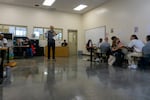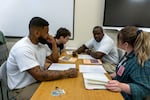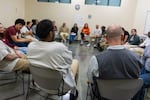In a beige classroom on a hill in Walla Walla, two dozen college students milled about a room.
Half of them attend Whitman College, which at one time had the greatest percentage of students from very wealthy families and the lowest percentage of students from poor families of any college in Washington state.
The other half live here, steps away from the classroom, at the Washington State Penitentiary. They have all been convicted of felonies. Most have at least six years left on their sentences.
You might not think these two groups would have anything to talk about. But they greeted each other like long-lost friends.
Whitman College has tried to offer one of these “inside-out” classes every semester since 2016. They’re part of a network of schools across the globe with such classes, including at least three others in the Northwest: Lewis & Clark in Portland, University of Oregon and University of Idaho.

Whitman’s inside-out class is competitive to get into. This past semester, there were roughly 50 applications for 24 spots.
Susan Shain / NWPB
Unlike what’s typically offered at prisons, inside-out classes allow both kinds of students to learn with and from each other, engaging in dialogue and forming relationships.
For inside students, it’s a chance to be known as more than their records. For outside students, it’s a reminder that all sorts of people are worth knowing.
Or, as one inside student put it: “ It makes me feel very human.”
Forgiveness and repair
The students sat at six rectangular tables around the edges of the room: For the most part, there were two incarcerated students and two Whitman students at each.
After they chatted for a few minutes, Mitch Clearfield, the course’s instructor, called them to attention. He read from “Moral Repair,” one of the syllabus’ main texts, then invited the students to discuss some ideas in their groups.
The class, called “Forgiveness and Repair,” met for 2.5 hours weekly from January to May. The students remained in the same groups for much of the semester. Clearfield, who teaches philosophy at Whitman, said that’s so students can build trust — an important factor when discussing sensitive issues like repairing damaged relationships.
“Everyone anticipates that it’s gonna feel awkward for a while and that people are gonna be hesitant to open up,” Clearfield said. “It is amazing how quickly they overcome that hesitation and really engage in honest and meaningful conversation.”

Mitch Clearfield, standing, teaches “Forgiveness and Repair,” as well as classes on applied ethics and restorative justice, at the Washington State Penitentiary.
Susan Shain / NWPB
This past semester, Clearfield got about 50 applications for 24 spots. He said he chooses the students, both from the inside and the outside, by their interest in the topic and their ability to “engage productively” with all kinds of people.
In the classroom, the students debated questions of forgiveness and repair for over an hour, as Clearfield and two assistants walked around and joined the discussions.
The concepts weren’t just scholarly, however; some of the students have applied them to their real lives.
One Whitman student said he realized he’d been too forgiving in the past. One incarcerated student said the lessons helped him smooth things over with his wife. Another said they pushed him to imagine the perspective of the people he’d hurt.
Related: State initiative helps Oregon inmates forge new career pathways
Mateo Car is a Whitman freshman who grew up in Walla Walla. Taking this class has shifted his view of the penitentiary: He now thinks his hometown is lucky to have it.
It offers opportunities, he said, for a new “perspective on life: getting to know people who aren’t similar to you, who did not grow up the same way you did.”
“I feel like many Whitman students are very entitled,” Car added. “And having an experience like this really brings you back down to earth.”
‘It’s like water if you’re dying of thirst’
Upperclassmen told Morgan Sherwood that she couldn’t leave Whitman without taking a class at the penitentiary. Sherwood is now a senior; she’s taken one class as a student and two as a teacher’s assistant.
“It’s been hands down the best thing I’ve done during my time at Whitman,” she said. “The connections I formed with students in all three of those semesters have been life-changing.”
Those connections are formed within the four walls of the classroom — and nowhere else.
Before the 14-week semester starts, students agree not to contact students from the other institution, during the class or afterward.
But the close-knit groups, the thoughtful conversations and the raw honesty — they stick with the students.
Related: New transfer degree gives Central Oregon prisoners a sense of hope
William Cyrus Lee, 31, is an incarcerated student from Montana. He’s taken three classes, including this one, and has worked as a teacher’s assistant for another. He appreciates the emphasis on open dialogue.
“It’s small, it’s personal,” he said. “And you really feel like you can open up and dive into topics that are nuanced enough to where you don’t have to have all the answers, but you’re not afraid of going through the process of trying to find them.”
To Lee, the fact that Whitman students go through “the entire rigamarole” — a background check, security measures and eight gates — to attend class with him is noteworthy in itself.
“It’s like water if you’re dying of thirst, like, ‘Oh wow, people care enough and actually think I have enough value to come in here,’” he said.
The history of inside-out
The concept of inside-out classes was pioneered by Lori Pompa, a criminal justice professor at Temple University and founder of the Inside-Out Prison Exchange Program.
Since 1997, the program has trained more than 1,500 people in its methodology, including Clearfield. There are more than 65,000 alumni.
Pompa, who’s taught between 60 and 70 inside-out courses, has consistently heard the word “life-changing” used to describe them. She’s not sure why, but she has a hunch.
“We create a space together where people invite each other to be their best selves,” Pompa said. “That’s exactly what happens. And it’s really quite beautiful.”
Related: Program bringing college classes to women’s prison has ‘really, really grown’
Martin Alvarez, 29, is an incarcerated student from Yakima. One of his counselors encouraged him to apply for the class. While he was resistant at first, he said the experience has brought him out of his shell.
“Before, I was never talkative,” Alvarez said. “These students from Whitman brought something outta me, and we had a lot of things to relate about. It kind of gave me that push that I really needed.”
When the Whitman students opened up to Alvarez, he surprised himself by opening up, too.
“I thought nobody would be willing to share with me,” he said. “And I was like, ‘You know what? Maybe I’m not the monster that I’m portrayed as in here.’ That softened my heart and it made me change a lot of my ways.”

Martin Alvarez, left, is taking his first inside-out class. It combines students from Whitman College with students from the Washington State Penitentiary.
Susan Shain / NWPB
A galaxy and a Subway sandwich
Clearfield ended class the same way he always does: by bringing the students together in a circle. He then prompted them to complete the phrase: “This class is like a…”
Responses included “a galaxy,” in which stars bond to each other; “a garden,” because everyone is growing; and “a Subway sandwich,” with many different varieties.
As people shared their answers, there was lots of good-natured ribbing and chuckles. One student started laughing so hard she could barely speak.
The group had the easy camaraderie of people who have known each other for years — or the accelerated affinity of people who have experienced something intense together.
“I’ve said things there that I haven’t told anybody,” said Lu Austin, a nontraditional Whitman sophomore who has spent decades as a hairstylist. “Old wounds are being reopened and healed, and it’s just been so absolutely beautiful.”
After the class, some students returned to dorms, others returned to cells. Austin returned to her house. But she was still thinking about class.
“No one cares how much you make, what you do, what you’re studying,” she said. “You leave your keys in the locker, your identity, your whatever, and you just get to be real and human.”
Austin, who wants to be a therapist, said she hopes to work at the prison after graduating — something she’d never considered before.

Clearfield ends every class by gathering the students in a circle.
Susan Shain / NWPB
Note: This story has been updated to reflect comments from Whitman College, which clarified that while the economic diversity data reflects the class of 2013 — the latest available — the college has since focused on growing that diversity. It notes that the proportion of students on need-based financial aid has risen by almost 15 percentage points since 2017.
Susan Shain is a reporter with Northwest Public Broadcasting. This story comes to you from the Northwest News Network, a collaboration between public media organizations in Oregon and Washington.
It is part of OPB’s broader effort to ensure that everyone in our region has access to quality journalism that informs, entertains and enriches their lives. To learn more, visit our journalism partnerships page.